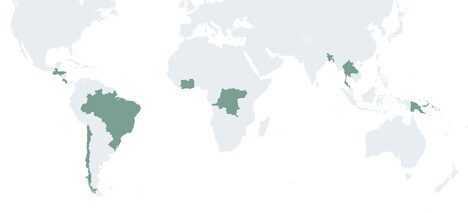Measurement, Reporting and Verification: moving towards the Enhanced Transparency Framework
Measuring and reporting REDD+ results
Forest reference (emission) level (FREL/FRLs) are benchmarks against which REDD+ performance is assessed. Estimates of emissions and removals compared against this benchmark are obtained through the process known as Measurement, Reporting and Verification (MRV). In the context of REDD+, FREL/FRLs and MRV are key to assess whether a country has managed to reduce emissions from forests and determine if a country could qualify for results-based payments. REDD+ is an important and complex theme in international climate policy and you can learn more here.
MRV for REDD+ has in many countries resulted in unprecedented transparency of forest-sector data, as these data have undergone international technical assessment for the first time. The experience gained from MRV is essential in moving towards the enhanced transparency framework (ETF) under the Paris Agreement, as countries aim to strengthen the global response to the climate crisis.
FAO has supported roughly three quarters of the 60 countries that have so far submitted a FREL/FRL to the United Nations Framework Convention on Climate Change (UNFCCC), and over half of countries that have so far submitted REDD+ results.

Here you can find an overview of the FREL/FRL submission to the UNFCCC and the REDD+ results submissions to the UNFCCC and the approved REDD+ results-based payment by the GCF. The latest update of this page was on February 2023.
Overview of FREL/FRL submissions to the UNFCCC:
- 60 countries had submitted 84 FREL/FRLs to the UNFCCC for technical assessment
- These FREL/FRL submissions collectively cover a forest area of approximately 1.5 billion ha (38% of global forest area) and the countries that submitted a REDD+ FREL/FRL to the UNFCCC are responsible for around 77% of global deforestation.
Overview of REDD+ results submissions (in the Biennial Update Report Technical Annex):
- Twenty-one countries had reported REDD+ results to the UNFCCC through 30 results submissions (in the REDD+ technical annex of their biennial update reports)
- The combined REDD+ results reported total 13.7 billion tonnes of carbon dioxide equivalent (tCO2eq).
Finally, as of early 2022, the following Green Climate Fund results-based payment milestones had been achieved:
- Eight funding proposals (Argentina, Brazil, Chile, Colombia, Costa Rica, Ecuador, Indonesia and Paraguay) for REDD+ results-based payments had been approved by the Green Climate Fund
- A total of 130 million tCO2 emission reductions have been offered to the GCF for RBPs.
- The approved funding proposals total an amount of USD 497 million, depleting the committed funds to GCF RBP phase 1.
Boosting transparency of forest data
FAO will continue to support countries in reporting to the UNFCCC and meeting and building upon their climate action goals until the transition to the ETF and beyond.
FAO National Forest Monitoring support to countries on MRV and ETF including the:
- Support in meeting requirements for FRELs/FRLs, REDD+ technical annex for the Biennial Update Report (BUR), National Communications (NCs), BUR, and when applicable, the Biennial Transparency Reports (BTRs), National Inventory Reports (NIRs) and National Determined Contributions (NDCs), including the exploration of practical solutions in line with these requirements, tailored to national circumstances and capacities
- Preparation of national greenhouse gas (GHG) inventories for different reporting requirements (NCs, BURs, BTRs, NIRs, NDCs) and specific applications, such as FREL/FRLs and REDD+ results reporting.
- Technical advice for the elaboration of BURs, BTRs, NCs, NIRs, NDCs, FREL/FRLs and REDD+ reporting.
Building global capacity to increase transparency in the forest sector (CBIT-Forest) is a project aiming to strengthen institutional and technical capacities of developing countries on forest related data collection, and analysis and dissemination processes to meet the ETF requirements of the Paris Agreement. This project will crucially help countries in the transition from MRV to ETF.
Countries where support is on-going or recently finished are shown on the following map:


